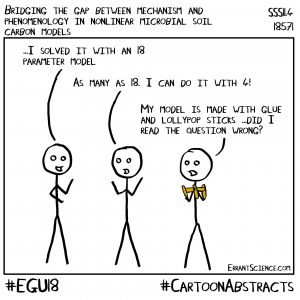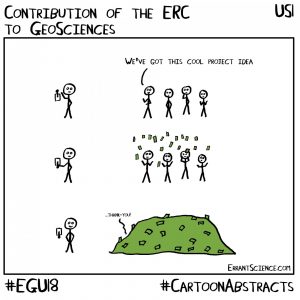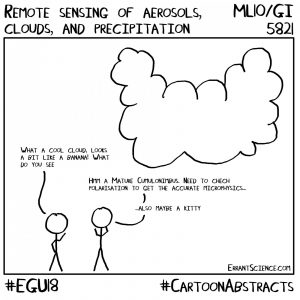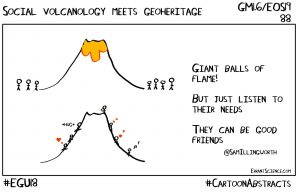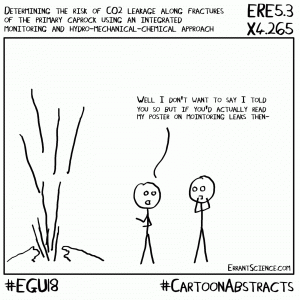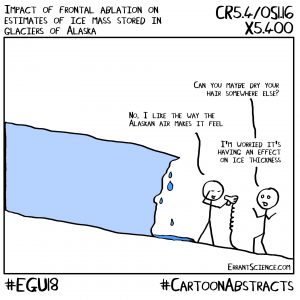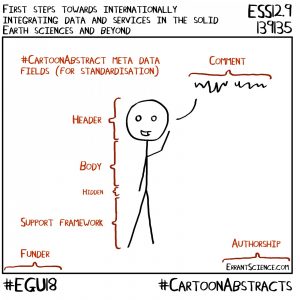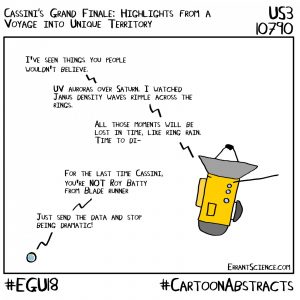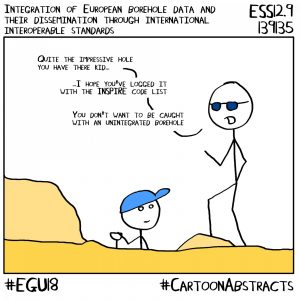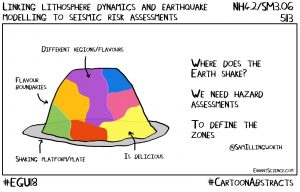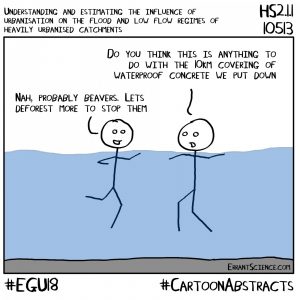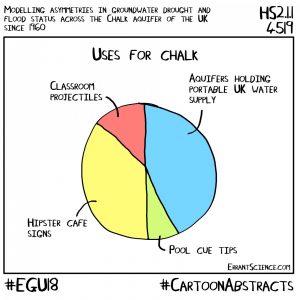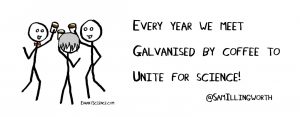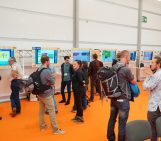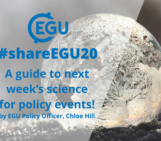
For the first time, the General Assembly will be documented by EGU’s very own artists in residence! Sam Illingworth, Science Communication Lecturer at Manchester Metropolitan University (UK), and Matthew Partridge, Senior Research Fellow at Southampton University (UK), have been busy this week producing poems and cartoons to share their conference experiences and communicate science. Why not take a break from the scientific sessions and enjoy the Assembly through a more artistic medium with this collection of poems and cartoons. This page will be updated with more of Sam and Matthew’s work as the week progresses.
Sunday:
A Lesson in Pico by Sam Illingworth
Presenting your work
In two minutes of madness
Challenges some and
Overwhelms others.
People try to explain every
Iota of detail and so they
Clean forget that it should be an
Overview or even better, a hook.
Persuade the audience;
Imbibe your short time with
Clear words and
Original illustrations.
Project and annunciate;
Impel them to listen as you
Carefully craft an
Opening statement.
Pique their interest, then…
Invite them to
Chat further at the
Oversized screens.
This is a didactic acrostic poem, offering some advice for PICO presenters at EGU. PICO (Presenting Interactive COntent) sessions take place at dedicated PICO spots throughout the EGU General Assembly and begin with each of the authors being given two minutes to present an overview of their work. After these short pitches, the authors each stand next to an assigned screen to show their interactive presentation in further detail to interested audience members, thereby combining the advantages of both oral and poster presentations.
Monday:
The View from Space by Sam Illingworth
Above the clouds they float like distant trains
Surveying moving forms and distant trends,
From blooming growth to violent hurricanes.
But every solar cell and compound lens
Has trade-offs that present a patent fact:
They’re simply more effective when with friends.
By working in a symbiotic pact
Nations and private companies can thrive,
Without it, possibilities contract.
With many new conductors set to drive,
The future’s bright if we can realign
Our differences to keep the dream alive.
And if we more effectively combine,
We’ll better understand our own design.
This is a terza rima, inspired by the Union Symposium at EGU 2018 about the future of Earth and planetary observations from space. In this session, researchers from a variety of space agencies discussed the challenges of organising space explorations, and highlighted the need for collaboration, both between different space agencies, and also between the public and private sectors.
Tuesday:
The Risk of Low-risk Geoengineering by Sam Illingworth
Mistakes we’ve made have borne their fruit,
As climate change has taken root;
The rising warmth we must now slow
To two degrees, or just below.
But are such efforts simply moot?
Is cleaning air that we pollute,
An action that we should dispute?
Not doing so could help to grow
Mistakes we’ve made.
Pour iron down the ocean’s chute!
But to what strength should we dilute?
Sulphuric clouds we can now sow!
But what about the rain and snow?
Do these ideas just substitute
Mistakes we’ve made?
This is a Rondeau, inspired by the EGU 2018 Great Debate on geo-engineering. Geo-engineering is defined as a deliberate large-scale manipulation of the planetary environment to counteract anthropogenic climate change. This debate investigated whether or not low-risk and safe techniques are currently available, weighing up their potential to counteract anthropogenic climate change with the risks that they might prove. Whilst geo-engineering methods exist, none of them are as safe, low-cost, or readily available as taking preventative action to reduce emissions in the first instance. Furthermore, they can lull people into a false sense of security with regards to the real and immediate danger of climate change.
A Skilled Scientist? by Sam Illingworth
When early in the course of our research,
We’re taught how skills can be both soft and hard;
Yet when between postdocs we start to lurch,
The ‘softer’ skills are met with less regard.
Design skills do not mean a winning grant,
Teamwork is not protection from the sack;
And whilst good leadership should not be scant,
It doesn’t guarantee a tenure track.
Despite what other scientists may say
There’s other jobs in which we could excel,
Where skills are valued for what they portray;
The money’s often better there as well!
No matter what new skills you learn or do,
Just find a way to make them work for you.
This is a Shakespearian Sonnet, written as a summary of the EGU 2018 Early Career Scientists’ Great Debate. This debate focussed on whether early career scientists should spend time developing transferrable skills and involved over 100 early career scientists working together via several roundtable discussions. This poem was written during the event to capture the overall sentiment of the conversations that took place.
Wednesday:
Half a Century of Drilling by Sam Illingworth
In search of riddles hidden deep
A Challenger was built to sweep;
Just off the Southern US shore,
We bore into the Ocean floor.
The biosphere was searched with probes,
Unearthing strange deep-sea microbes;
With every gas hydrate or pore,
We bore into the Ocean floor.
Revealing methane locked in vents,
Now frozen into sediments;
Assessing every risk and flaw,
We bore into the Ocean floor.
By counting all the slips and slides,
We map the planet’s moving tides;
As ancient quakes reveal their lore,
We bore into the Ocean floor.
A record of our climate past,
Preserved within a shaly cast;
In search of what went on before,
We bore into the Ocean floor
Despite the secrets we now know
More truths are hiding down below;
There’s much to find and so once more,
We bore into the Ocean floor.
This is a Kyrielle, inspired by the EGU 2018 Union Symposium on 50 years of ocean drilling. In March 1968 a ship called the Glomar Challenger was constructed with the purpose of drilling up to 800 m below the seafloor. The Deep Sea Drilling Project began in the Gulf of Mexico in mid-August 1968, using the facilities of the Glomar Challenger and marking the start of 50 years of successful drilling. This session provided an overview of the research that has been made possible by this international and interdisciplinary ocean drilling program.
Games for Geoscience by Sam Illingworth
Well-crafted games can be a useful tool
For helping different publics find their way;
As Plato said: “Life must be lived as play”,
From lawmakers to children still at school.
But research should help underpin each rule,
And fun should make the players want to stay;
Well-crafted games can be a useful tool,
For helping different publics find their way.
From showing how volcanoes can be cruel,
To helping farmers find a waterway;
Forecasts can be enhanced through good roleplay,
Whilst Zelda has made batholiths seem cool.
Well-crafted games can be a useful tool.
This is a Rondel, inspired by the Games for Geoscience session that took place at EGU 2018, and the accompanying Geoscience Games Night. During this session, participants presented research on using analogue, digital and/or serious games to communicate geosciences to different audiences. The Games Night presented an opportunity for EGU participants to play a selection of these games, and to provide feedback and playtesting for the game designers. These sessions were organised as a collaboration between the SeriousGeoGames Lab and the Games Research Network.
Thursday:
Cassini by Sam Illingworth
You voyaged in the trail of pioneers,
To shed new light on Saturn and its rings;
By imaging its many circling spheres,
We glimpsed into the past of Earthly things.
Your Equinox and Solstice both burnt bright,
Revealing lightning in the darkest night;
And through your Grand Finale in the sky,
Your sacrifice means you shall never die.
This is an Heroic Rispetto, inspired by the EGU 2018 Union Symposium on the Cassini-Huygens Mission to Saturn, a collaboration between NASA, ESA, and the Italian Space Agency. Over a period of 13 years, Cassini successfully returned a huge amount of data that has since been used to enhance our understanding of Saturn and its system, including in-situ sampling of Saturn’s upper atmosphere, and high-resolution imaging of Saturn, its rings, and several of its many moons. The two different phases of the Cassini mission were termed Equinox and Solstice, ending with a dramatic plunge into Saturn’s atmosphere on September 15, 2017, with the spacecraft continuing to record and transmit data until the very end.
Regional Impact on a Global Scale by Sam Illingworth
We map the future climate of our Earth,
And model global patterns that might be;
By giving different regions certain worth,
These maps might hide the truth we want to see.
The coarse and fine will often disagree,
Improving some and making others worse;
By making all these models fair and free
Research can be inclusive and diverse,
Providing new predictions that are not adverse.
This is a Spenserian stanza, inspired by the 2018 Alexander von Humboldt Medal, which this year was won by Filippo Giorgi. This medal, named after Alexander von Humboldt, is awarded to scientists who have performed research in developing regions for the benefit of people and society. Giorgi pioneered the field of regional climate modelling and helped to develop the Regional Climate Model system (RegCM), which is used by a large scientific community worldwide. Regional climate models are needed to enhance the coarse resolution that is offered by global climate models, and the RegCM is flexible, easy to use, and can be applied to any region of the world. The RegCM model is also free to use, and the workshops and feedback that is provided by Giorgi and his team mean that it is particularly attractive to scientists from developing regions. These scientists can then use the model to better understand problems that are of high interest for local conditions in their countries, which in turn can be used to improve the both regional and global climate models.
Friday:
Medical Geology by Sam Illingworth
To benefit from minerals underground
And better understand the roles they play,
A balance in our intake must be found.
Spewed outwards from a deep volcanic mound
We measure how these clouds disperse away,
To benefit from minerals underground.
Effects on human health can be profound,
Abundances and droughts can cause dismay;
A balance in our intake must be found.
When traces sink below the safe background
We search for missing parts in soil and clay,
To benefit from minerals underground.
The danger of asbestos is renowned,
We toil to better map out its decay;
A balance in our intake must be found.
The synergies continue to abound,
The Earth and human system is two-way;
To benefit from minerals underground,
A balance in our intake must be found.
This is a Villanelle , inspired by the EGU 2018 session on Medical Geology, and its role as an interdisciplinary field of science for the benefit of the society. Medical Geology is defined as the science dealing with the relationships between geological factors and health (for both humans and animals). This emerging field adopts an interdisciplinary approach, and the session featured presentations from environmental and public health experts, animal health professionals, and geoscientists on topics that ranged from the risk of exposure to humans from naturally occurring asbestos in Southern Nevada, to the healing thermal waters of Ischia—a tiny volcanic island in the Gulf of Naples.
Better Together by Sam Illingworth
The planet that we live on is a tangled mesh
Of interacting systems and processes;
From fluvial dynamics to sedimentary deposits,
Everything we see and feel
Floats on the Earth’s tectonics.
We map and measure the stresses and strains
Arisen from the risks and hazards
That are naturally occurring,
Then temper this with cold hard fact
That humans have the
Worst IMPACT.
As well as navel-gazing…
We point
Our instruments to the stars,
Grazing the rings of Saturn
And looking for water on Mars.
SPOILER ALERT: we found some.
I don’t mean to whitewash
Our achievements.
I mean we’ve been drilling
The ocean floor for over fifty years
And we still know less about what’s down there
Than the surface of Venus.
Oceanographers: this is heinous!
Geodynamicists: you also need to do better.
Hydrologists: wipe that smile off your face,
I was promised
The scaling law for the threshold function of the unsaturated reservoir;
Sort it out!
But this is all in the past.
Scientific research is changing,
We can no longer be the people who
Simply collect data and say:
‘Oh, fancy that!’
We should turn our hopes and methods into
Good IMPACT.
Diversity and equality are not just
Boxes we must tick
Without different people’s voices
Our science will get sick.
Every year we come together,
To find friends new and old;
Now we need a better method
To help others’ dreams unfold.
Politics will try to divide us,
I say: let it try!
Climate change is anthropogenic,
As sure as the sun sets in the sky.
And even when Brexit
Turns my passport blue,
I’ll still be the first letter in EGU.
With so much accomplished,
And so much to be done,
Let’s make this a home
For me,
You,
Everyone.
This poem was written as a summary of EGU 2018, in an attempt to capture the essence of the General Assembly, and the highlights that I experienced whilst poet in residence. Throughout the assembly there were so many positive messages of inclusivity that I wanted to capture those in my final poem. It has been an honour to be the poet in residence, and I hope that my poetry has helped to communicate some of the amazing research that is represented across the whole of the European Geosciences Union.
Our poet in residence at the Assembly is Sam Illingworth, Senior Lecturer in Science Communication at Manchester Metropolitan University (UK). In addition to running the short course ‘Rhyme Your Research’, Sam will be organising a series of poetry clinics in the ECS lounge and hosting a poetry slam at the Convener’s Reception. You can find out more about Sam’s research, and read some of his poetry by visiting his website: www.samillingworth.com
Our cartoonist in residence at the Assembly is Matthew Partridge, Senior Research Fellow at Southampton University (UK). Matthew will be leading a short course on ‘How to cartoon science’ as well as creating cartoons that illustrate his experience at the 2018 General Assembly. Learn more about Matthew and read up on his cartoons at https://errantscience.com/


